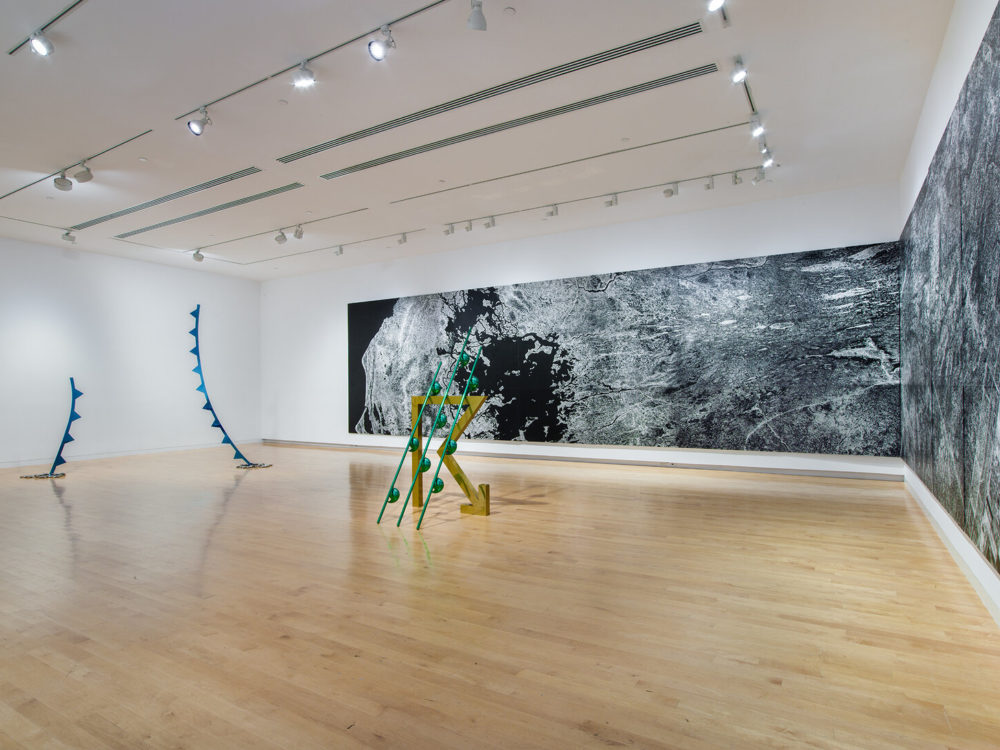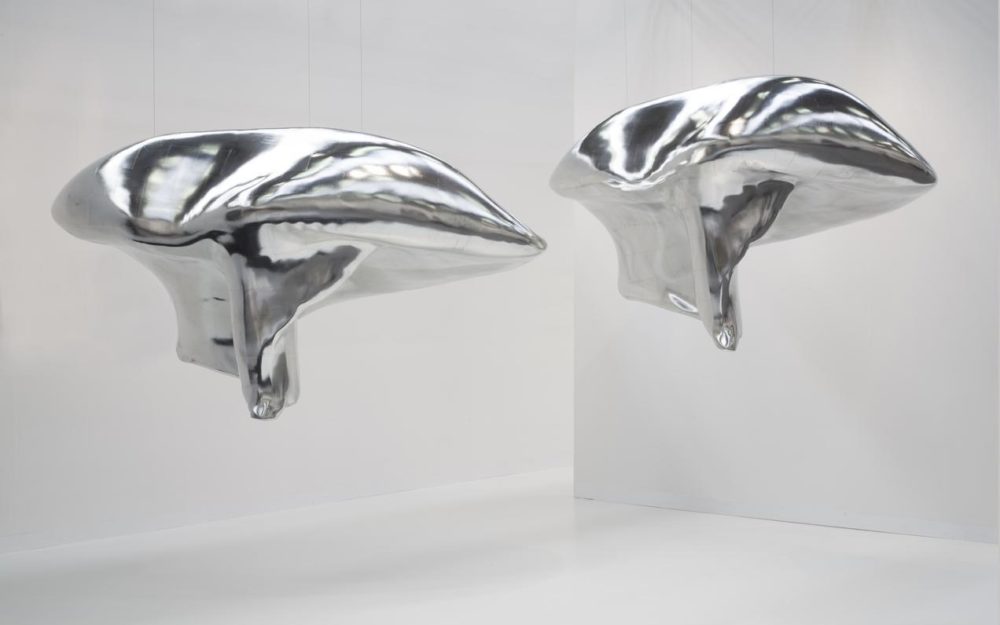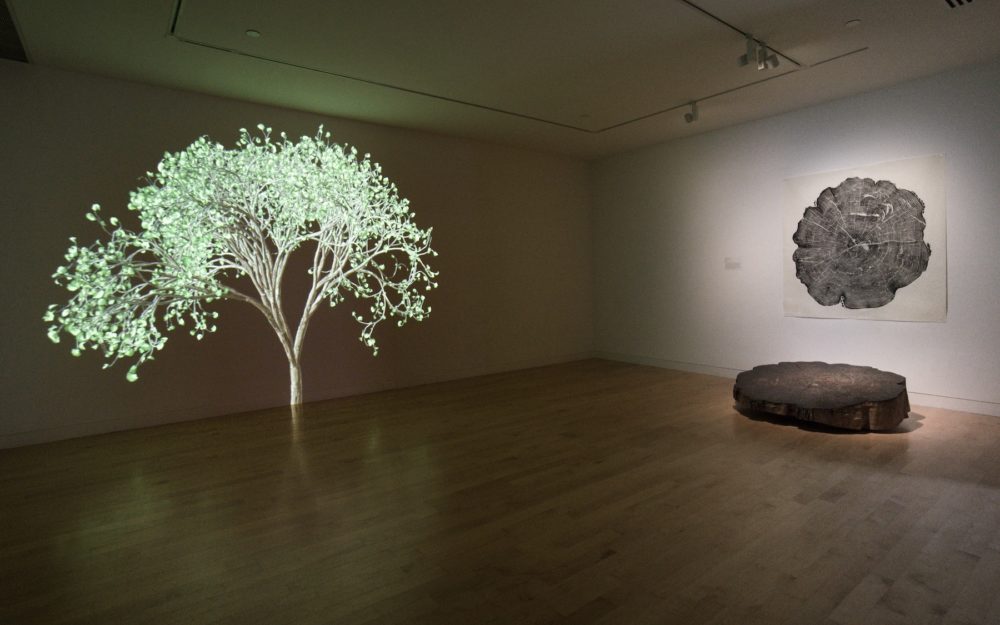- We’re open today from 10 am to 5 pm
- Purchase tickets
- Join mailing list
- Join as a member
- Donate

Getting Your Weather Report at the Art Museum, Hyperallergic
By Louis Bury
Climate-themed art has never seemed more visible or timely. At the 2019 Venice Biennale, for example, the Lithuanian Pavilion received the Golden Lion award for its beachy dramatization of our species’ climate anxiety, Sun & Sea (Marina) (2019), while The Brooklyn Rail organized a massive eco-themed satellite group exhibition at Venice, Artists Need To Create on the Same Scale That Society Has the Capacity to Destroy: Mare Nostrum. The greater New York region, my own beat, has seen no shortage recently of ambitious eco-art group exhibitions: Storm King Art Center’s 2018 Indicators: Artists on Climate Change; Wave Hill’s 2018 Ecological Consciousness: Artist as Instigator; the Princeton Art Museum’s 2018-19 Nature’s Nation: American Art and Environment; the Cooper Hewitt Smithsonian Design Museum’s 2019-20 Nature Triennial. In each case, the curators did an excellent job tailoring the show to the unique location and mission of its host institution.
The Aldrich Contemporary Art Museum’s ethereal group show, Weather Report, organized by Exhibitions Director Richard Klein, is similarly felicitous in its design. The Aldrich was founded as a collecting museum in 1964 by fashion designer and art collector Larry Aldrich, but deaccessioned its permanent collection in 1981 to become a Kunsthalle-style venue for showcasing work by emerging and under-recognized contemporary artists. Just as a Kunsthalle’s programming can serve as a barometer of an art scene, Weather Report implies that a group show can serve as a barometer of a given subject or theme, in this case earth’s climate. Yet the title also implies a level of timeliness — a regular update on conditions — unavailable to large group exhibitions, which can require years of involved planning to realize. The artworks in Weather Report confront their own untimeliness, in news cycle terms, through appeals to a deeper, more cosmic, sense of space and time, as well as the incorporation of the scientific tools that humans use to apprehend the planet’s atmosphere.
The row of Byron Kim’s beguiling, blue-and-white Sunday Paintings (2001–present) in the entry hallway sets a ruminative, airy tone. Each canvas in the ongoing weekly series offers a porthole-sized glimpse of one Sunday’s sky, overlaid with a diaristic handwritten paragraph overlaid. Kim’s deceptively simple play on hobbyist painting contrasts the quotidian vicissitudes of terrestrial life with the heavens’ gauzy indifference. Upstairs, Ayumi Ishii’s gossamer “The Breath from Which the Clouds are Formed” (2015) and Jitish Kallat’s shapeshifting Rain Study series (2017) also turn on subtle contrasts between above and below. The latter look like straightforward drawings of astronomical charts but the artist incorporates rainwater filtered through stencils to depict nighttime stars as splotches of negative space. The former artwork consists of a grid of 50 soothing digital prints, each apparently depicting a wispy cloud against a clear blue sky. However, only half the photographs depict actual clouds; the other half are of Ishii’s breath on paper treated with thermochromic pigment. The indistinguishability of the two subjects from one another posits the human breath as a pervasive, if modest and invisible, component of the planet’s atmosphere.
The interplay between earth and sky, human and non-human, heaviness and lightness, is even more pronounced in other works. Iñigo Manglano-Ovalle’s “Storm Prototype” (2007) renders data on supercell thunderstorms as two bulky, brain-shaped metallic abstractions that hang from the ceiling; the sculptures’ reflective aluminum leaf surfaces give them a buoyant sheen yet their visual solidity, as well as their proximity to the floor, bespeak heft The prickly, multicolored swirls of Nick Cave’s circular mixed-media wall hanging, “Tondo” (2018), also convey unease: the work’s hurly-burly abstraction derives from Doppler radar images of cataclysmic weather combined with brain scans of black youth suffering from gun violence-related PTSD. Barbara Bloom’s Some flawed place in the iron dark of the world. (McCarthy) (2015) lowers empyrean weather near to the ground by translating novelist Cormac McCarthy’s description of a thunderstorm into braille bumps on a hand-tufted, charcoal-colored wool carpet.
Feats of literal and figurative translation are everywhere in Weather Report, and they are of particular importance in representations of scientific data and imagery. In “First Look at the World’s Weather” (1973), for example, Nancy Graves renders a weather satellite global photomosaic as a black-and-white pointillist composition; the Rorschach-esque result, which looks like standard issue abstraction until you know its referent, hints at the tug-of-war between appearance and informational content in artworks about science. This same tension manifests in scientist Amanda Bunce’s under-aestheticized “Tree Sway” (2019), the exhibition’s lone contribution by a non-artist. In it, a video monitor livestreams footage of a white pine tree on the museum’s campus, whose movements are measured by an inclinometer. The inclusion of a purely scientific work makes sense, given the exhibition’s theme, but the feed’s glacial pace and dry, technical information — “[ 41 .27770, -73.4958]” — may feel off-putting to some viewers.
Weather Report thus raises the question of how art can best to communicate information about the planet’s climate. It’s a question whose implications extend beyond the realm of aesthetics. However dazzling, artworks that show a bird’s-eye perspective— a crowd-pleasing sub-genre of landscape art — that includes work by contemporary artists such as Ed Burtynsky and Zaria Forman — increasingly feel dissatisfying. For example, segments of Ellen Harvey’s enormous, painstakingly detailed black-and-white painting, in acrylic and oil, of Florida Coastline, “The Mermaid: Two Incompatible Systems Intimately Linked” (2019) — designed to span a 100-foot-wide wall in the Miami Beach Convention Center as part of the Miami Beach Art in Public Places Program — impress simply by virtue of their size. But, at least when installed in a geographically distant gallery, the painting’s impersonal vantage point minimizes the coastal region’s imperiled, ground-level climate realities.
Humor can perhaps convey a more effective sense of the distance between our ant-like human lives and the larger climatic forces threatening the viability of those lives as we’ve known them. Smartly situated in the same room as Graves’s and Harvey’s paintings, Swedish duo Bigert & Bergström’s sculptures, “The Russian Campaign 1812” and “Teutoburg Forest 9 CE” (both 2017), depict weather events that influenced the course of military history as pop-camp versions of weather report graphics. The shiny and colorful painted stainless steel objects—a group of Shamrock green bars from which dangle apostrophe-shaped raindrops; silver, asterisk-shaped snowflakes clustered on the floor—playfully send up the way in which meteorology’s visuals abstract weather from its harshest historical and experiential consequences.
Josh Callaghan’s Chicago Snow (2013) series portrays one such human-scaled consequence with understated humor. The small, jagged foam sculptures are coated with resin, sand, and other materials to resemble partially melted clumps of polluted snow. Encountered on a gallery floor rather than a city sidewalk, the lifelike clumps are droll, uncomfortable reminders of urban pollution’s normalization. Similar to Ishii’s nearby cloud/breath grid, Chicago Snow commingles the celestial with the terrestrial, the natural with the anthropogenic; however, unlike “The Breath from Which the Clouds are Formed,” there’s a conspicuous contrast here between weather in its pristine state and weather covered in our species’ grimy fingerprints.
Like Chicago Snow’s depiction of pollution’s traces, numerous other works in Weather Report also operate by means of the trace, suggesting that art’s capacity for poetic indirection helps convey climate subtleties that might elude purely informational modes of address. For example, Pat Pickett’s scraggly collaborative drawings with trees — in which the artist affixes pens to branches, which mark up nearby, tripod-mounted paper when the wind blows — capture a surprisingly agitated record of tree branch movement that is more visually evocative than “Tree Sway.” Sara Bouchard’s “Weather Box” (2014), which represents New York City weather data as punch card scores playable on a music box, transforms prosaic meteorological data into poetic plinks and echoes. Hitoshi Nomura’s “Time Arrow: Oxygen -183° C” (1993) consists of a glass flask whose steamy, blueish interior captures the visual effects of liquid oxygen’s evaporation process. Bryan Nash Gill’s somber wood relief print of a tree trunk cross-section, “Ash” (2003), presents a trace (the internal rings that constitute the tree’s record of aging) by means of a trace (the print’s inky impression).
As poetic intimations of time’s passage, aesthetic traces are well-suited to depict not only weather’s quotidian ups and downs but also climate change’s seismic and harder to fathom consequences. Part of what makes anthropogenic climate change a wicked problem — the social planner’s term for a problem whose incomplete, contradictory, or changing nature makes it difficult to recognize, let alone solve — is that many of its most harmful effects take place on long-term time scales that human beings can’t easily account for in our short-term decision making. Even if you understand, intellectually, that disposable coffee cups cause gradual harm to others across space and time, it can be hard, emotionally, to care about those intangible consequences when you’re tired and without other options for caffeine.
Weather Report’s artworks confront us with the insidious depth and extent of such climate entanglements. Nowhere is this dizzying interconnectedness more succinctly illustrated than in Colin McMullan’s “Clouds Filtered through Trees” (2019), which consists of an almost-seven-foot tall water cooler that resembles a laboratory beaker and dispenses rainwater captured from the museum’s roof and filtered through white pine tree sapwood. “NOTICE,” warns a text affixed to a nearby window, “RAINWATER MAY CONTAIN/ UNRECOGNIZABLE TRACES OF/ Ancestral indigenous land stewardship/ Tap water with elevated lead from municipal neglect/ Mercurial soot from coal fired power plants.” In both form and content, McMullan’s artistic water cooler serves, fittingly, as a conduit between earth and sky, human and non-human. Just as fitting, its tainted contents taste indistinguishable from all the other water we unthinkingly consume.
Related Exhibitions
Weather Report
Related News
When Art Captures the Wind and the Rain—and a Bit of Ourselves, NRDC
“Weather Report” fills a Connecticut museum with the works of 25 artists who explore what’s happening in the atmosphere and, inextricably, to us.
Weather Report Exhibit at The Aldrich Goes Beyond Clouds and Rain, The Ridgefield Press
A diverse selection of art ranging from drawings and paintings to sculptures, videos and installations — all featuring weather as the thematic subject — is on view at The Aldrich Contemporary Art Museum.
Artists on the Verge of an Ecological Breakdown, Elephant
Over the years, many artists have have proven themselves to be staunch supporters of environmental campaigns.
Top image: Ayumi Ishii, “The Breath From Which the Clouds Are Formed” (2015), 50 digital prints (courtesy of the artist)



